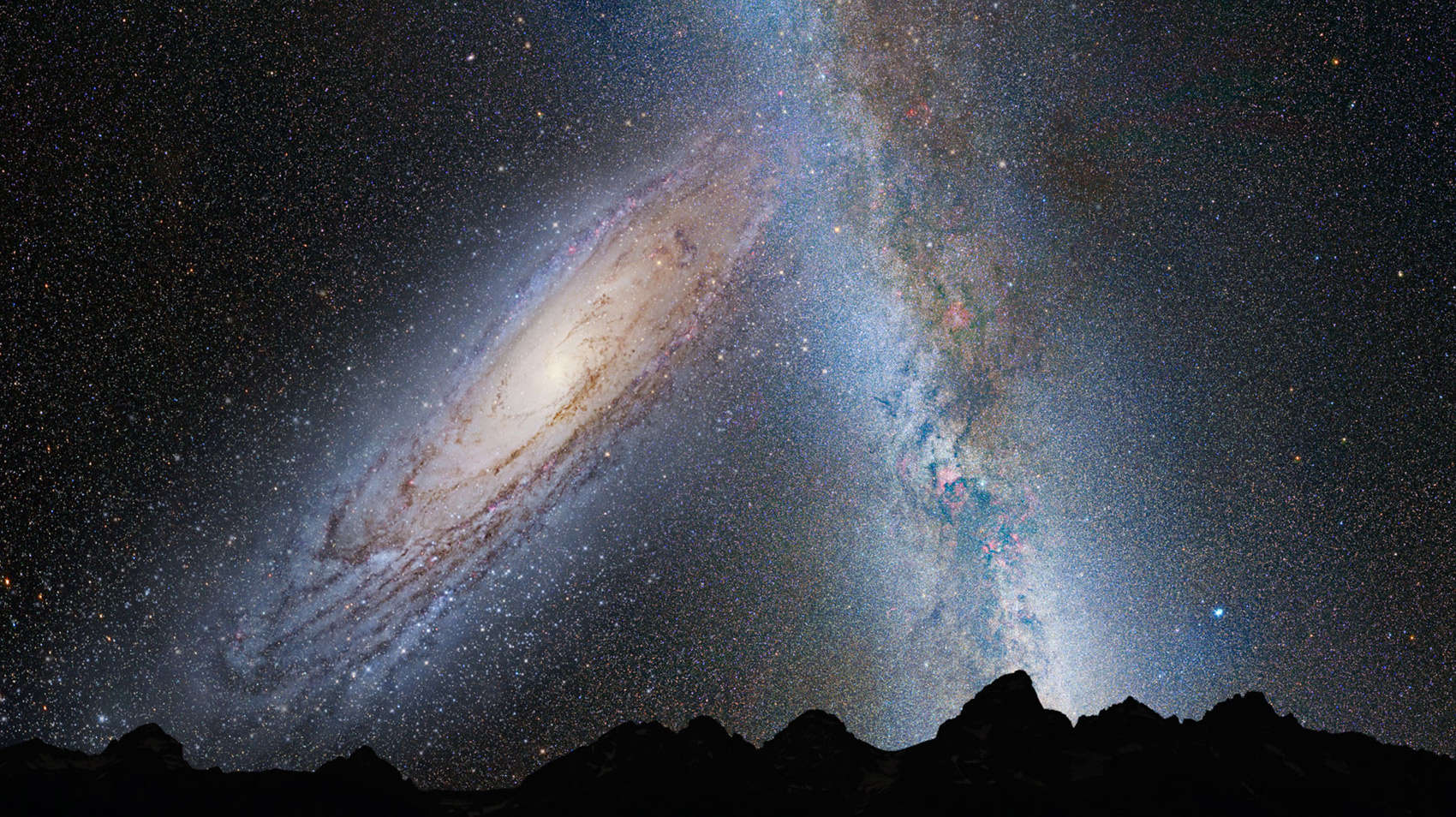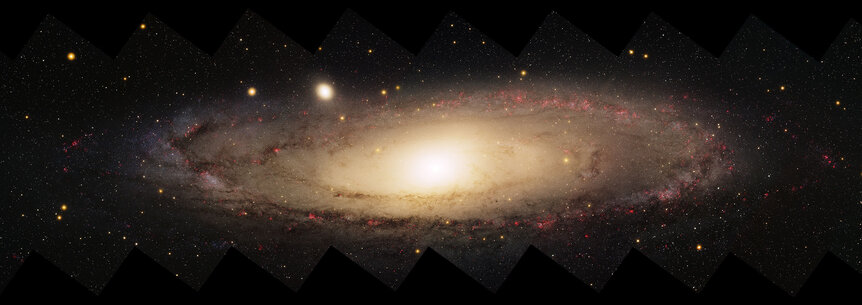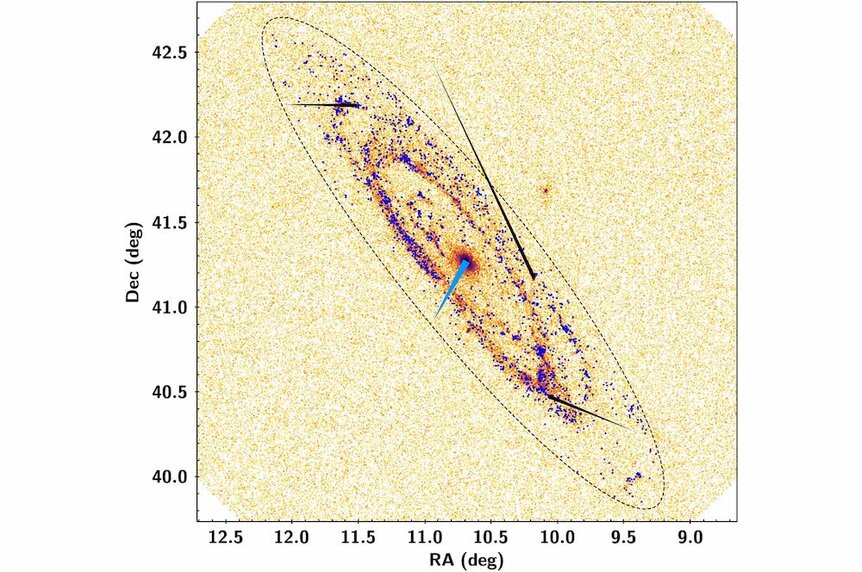Create a free profile to get unlimited access to exclusive videos, sweepstakes, and more!
Uncertain future: Is Andromeda going to collide with the Milky Way or not?
The Andromeda galaxy may or may not collide with our own in 4 billion years.

In 2012, astronomers announced a startling result: The had used Hubble to very carefully measure the motion of the Andromeda galaxy, and found that it appeared to heading very nearly directly toward the Milky Way at 100 kilometers per second. They predicted that in about 4 billion years the two galaxies would collide, and chaos would ensue.
In 2019, an update to the measurements indicated that Andromeda was sliding to the side a little bit more than previously thought, delaying the inevitable collision by about 600 million years.
But now new results have been published using updated data, and they imply that Andromeda's sideways motion still higher yet. If true, it's possible that Andromeda could miss the Milky Way entirely on this pass.
The bizarre thing is that, while all these measurements seem to contradict each other, in fact at some level they all agree with one another! The problem here is statistical uncertainty in the measurements, because the numbers involved are very small and extremely difficult to determine.
The Andromeda galaxy and the Milky Way are the two biggest galaxies in what we call the Local Group, a collection of several dozen galaxies large and small all held together by their own gravity. Because Andromeda and the Milky Way are the beefiest they dominate the gravity and therefore the future of the group. For example, if the two big members orbit each other in a circle, always staying the same distance away from each other, then the group will pretty much stay the same over time.
But if instead the two are headed right for each other, on a head-on collision course, that will change the structure of the group on a huge scale. When massive galaxies collide they fling stars and gas everywhere, distort each other into fantastic and weird shapes, and then eventually merge into a single, much larger galaxy.
So are we headed toward each other or not? [WARNING: very mild high school math ahead]
The velocity of an object can be broken down into two component directions: How fast it's moving toward or away from you (called the radial velocity), and how fast it's moving to the side (the transverse velocity). If something has some velocity toward you and 0 transverse velocity, brace for impact. But if it has some positive transverse velocity then it's moving sideways as well as toward you. If the transverse velocity is high enough than it'll miss.
Measuring the radial velocity of Andromeda is actually pretty easy, because Nature provides a built-in way to do that. When an object heads toward you its light is Doppler-shifted, and its wavelength gets shorter (we call this blue-shifting). This can be measured with relative ease and accuracy by taking spectra of the galaxy, and has been found to be about 100 kilometers per second, or 360,000 km/hr. Fast.
OK, but what is its transverse velocity? How rapidly is it moving sideways? That's the key question.
And it's extremely hard to measure. Andromeda is 2.5 million light years away, which is a long way: 25 million trillion kilometers. Think of it this way: Saturn is roughly a billion kilometers from Earth, which is a long way (it took the Cassini spacecraft 7 years to get there). Imagine going to Saturn, then back to Earth. Now do that again a billion times.
Congratulations! You have traveled the equivalent of a mere one-tenth of the way to Andromeda.
So Andromeda is hugely far away, and that makes any transverse motion look incredibly small, and that means it's hard to measure. Just measuring the tiny change in positions of its stars year to year is beyond the capability of most telescopes. In the first paper mentioned above, astronomers used Hubble to make incredibly precise measurements over 5–7 years to measure how quickly Andromeda was moving to the side, and got a velocity of 17 km/sec. That is much smaller than the 100 km/sec radial velocity, so for all intent and purpose it's headed right toward us.
In the new work astronomers used the latest data from the Gaia spacecraft, which measures the brightness, positions, motions, and colors of well over a billion stars to incredible accuracy. The procedure is complicated, but what they find in the end is that Andromeda's transverse velocity is about 82 km/sec.
At face value, that implies Andromeda will miss us! If the transverse and radial velocities are about equal (and 82 is pretty close to 100) then this adds up to Andromeda heading at about a 40° angle to the side, enough to completely miss the Milky Way.
So which is right? Ah, this is the fun bit.
As I said, these measurements are extremely tricky, and involve a lot of uncertainty. Using various statistical methods, astronomers can assign a statistical uncertainty to their findings. For example, the first measurements using Hubble have an uncertainty of plus or minus 34 km/sec. So the actual measurement is 17 ± 34 km/sec, which is consistent with 0. In other words, it's headed right toward us. But statistically speaking, any velocity between -17 and +51 (think of it as heading from a little to the left to heading more to the right) is just as likely.
Also, the way statistics works, you can't rule out any velocity that's within twice the uncertainty (it's less likely, sure, but not even terribly unlikely), so a velocity of -51 to + 85 may yet be possible.
The new results from Gaia are actually 82 ± 31 km/sec. So it could really be anything from 51 to 113, and you can't rule out anything from 20 to 144!
That's a big range. And note the measurements from Hubble and Gaia statistically overlap, too. The high end of the Hubble numbers overlaps the low end of Gaia's. So even though the nominal measurements of 17 and 82 seem far apart, due to the large uncertainties we can't rule either out!
That's annoying. If the lower number is right that practically guarantees a collision. If the higher one is it guarantees a miss. And we can't say which is which.
The good news is it's entirely possible to figure this out. All we have to do is wait.
Seriously. We're trying to measure the apparent motions of stars over time. The longer the time between measurements the more they move, and the more certain the measurements become. The first Hubble paper came out nearly ten years ago, so if it were repeated now the numbers would be a lot more dependable. And Gaia is still making observations as well. Updated data from Gaia are expected in early 2022, and another release will occur after all five years of the nominal mission are processed, and are expected to be far more accurate than previous data.
So give astronomers a few more years and these numbers should tighten up. And then, hopefully, we'll know for sure whether in an eon or four we'll need to either fasten our seat belts for a cosmic collision or watch as Andromeda safely flies past us a million or two light years distant.
Patience.
My thanks to lead author Jean-Baptiste Salomon for clearing up a couple of question I had. Any potential errors in this article are mine, though.





























